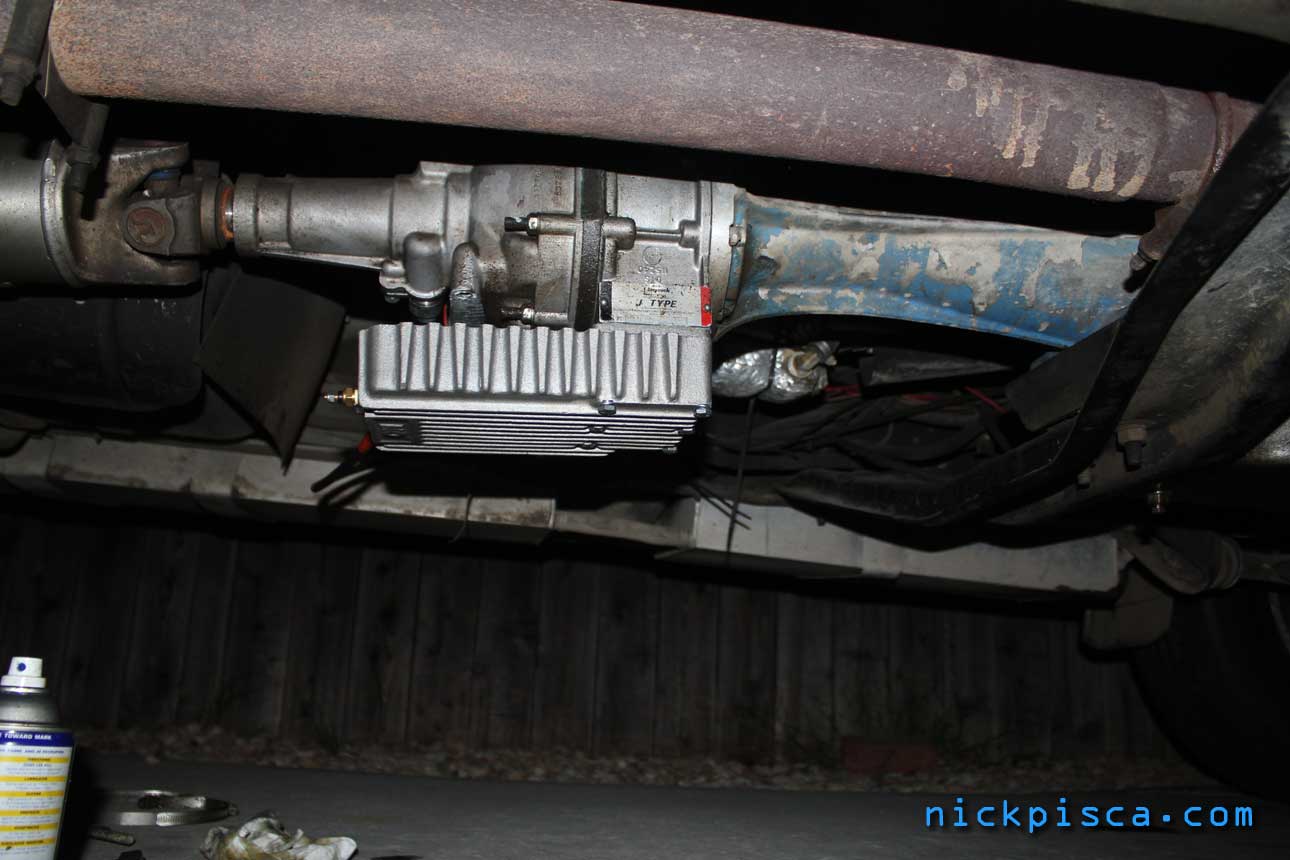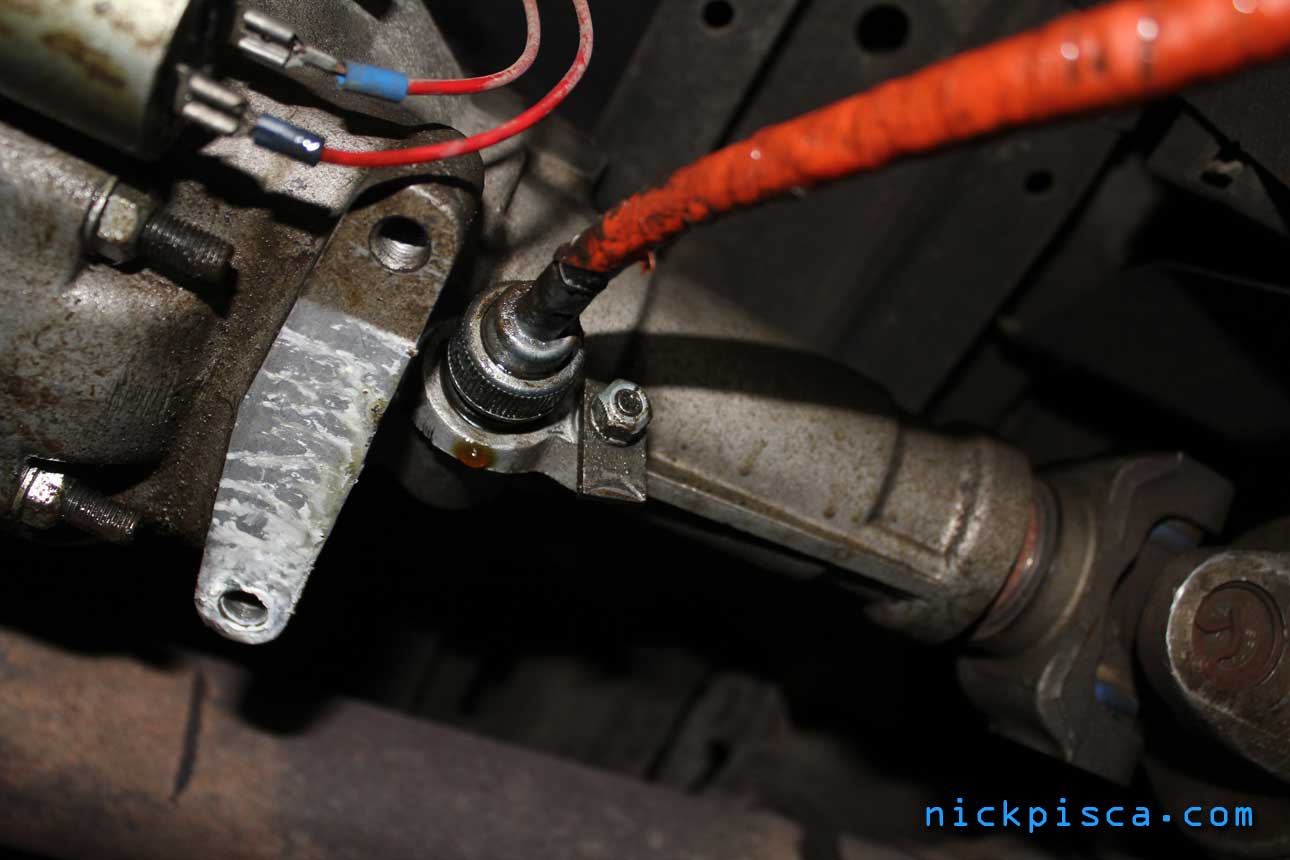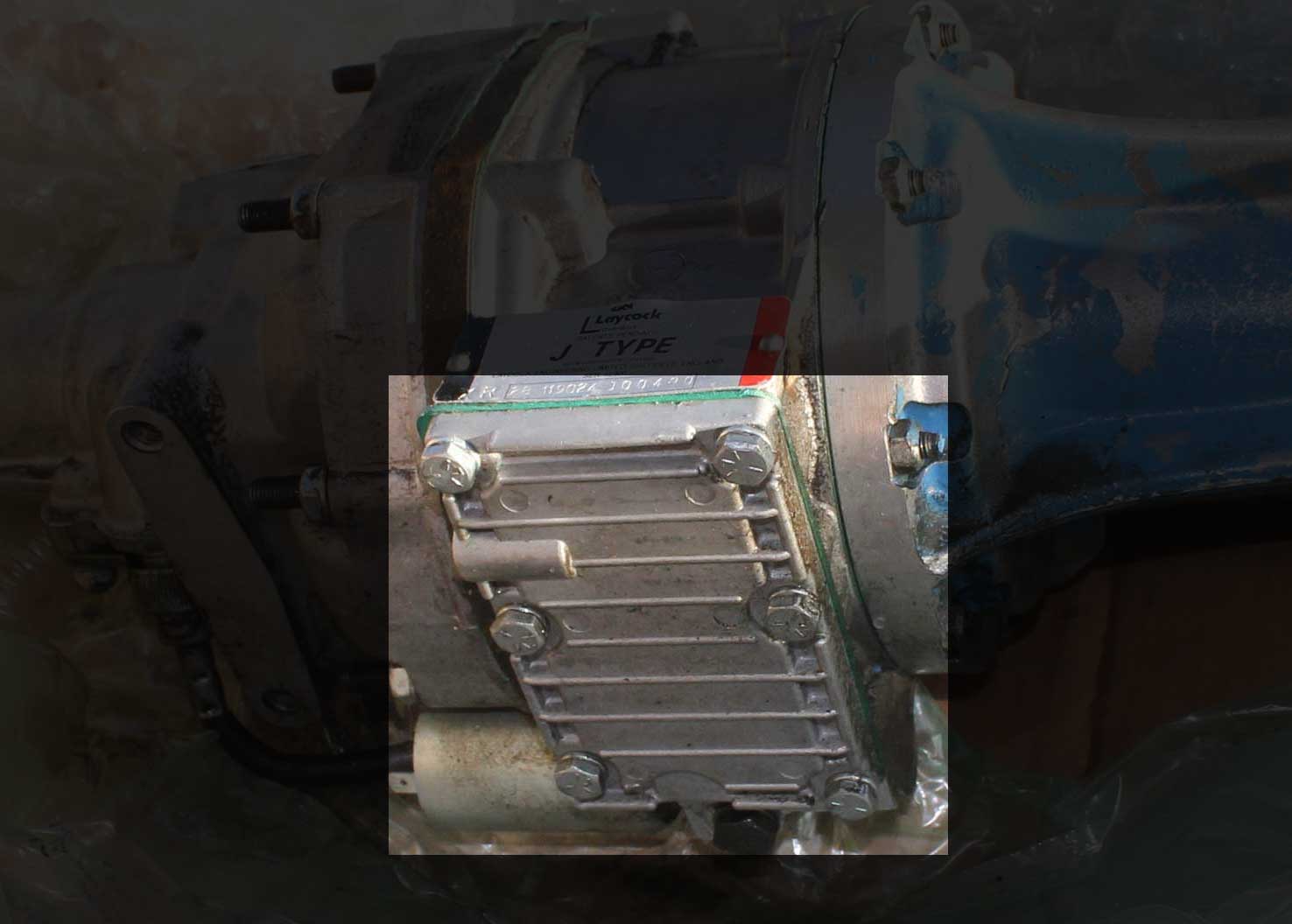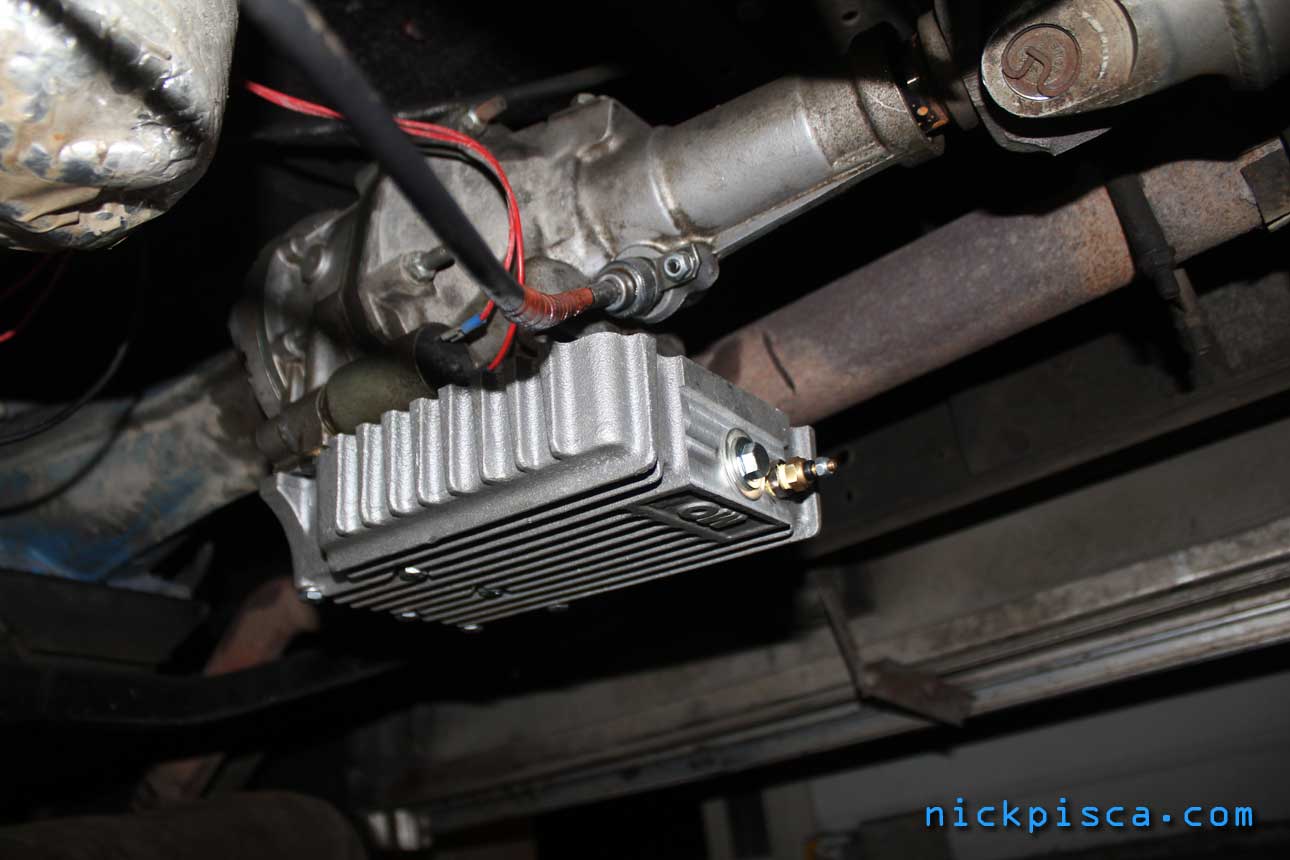You should read this if you are hunting for a used Gearvendor. It’ll help you figure out what you need from the junkyard. The Gearvendor overdrive setup is a vast array of disparate parts, and missing just one can make your install a nightmare.
Tailshaft Housing:
Personally, I wouldn’t even entertain a GVOD purchase without the Tailshaft Housing. This is probably the most crucial Gearvendor part of all the assembly. The overdrive unit itself isn’t that hard to find; actually, they are rather interchangeable with other makes and models of cars. The J-type unit I think was run in Volvos or some small car. So, when shopping for Gearvendor kits, the most important part to obtain is the tailshaft housing that fits your transmission. There are different Gearvendor tailshaft housings for the C6, or the E4OD tranny, or any other tranny. Also, there are different housings for 4×4’s.

The Tailshaft Housing is the blue item in this photo. It replaces the stock tailshaft housing on your transmission.
I think I remember Maximum Overdrive selling a new C6 tailshaft housing for several hundred bucks and Gearvendor selling theirs for over a grand. I can’t remember though, so don’t take my word for it. I read when i was looking for GVOD’s, that finding a used tailshaft housing was as rare as hen’s teeth, since most junkyards don’t know the GVOD is a package deal (tailshaft housing plus the unit). So they just trash the housing or leave it on the tranny, and I’m sure some sucker who buys the tranny will be extra confused on what the H happened to the end. Also, there is a heavy-duty metal cylinder that is used to splice the tailshaft to the GVOD shaft. If the tailshaft housing is missing, i doubt the cylinder is in the kit too since it was just held in by the compression of the tailshaftto the unit itself.
Driveshaft Yoke:
Try to find the GVOD yoke from the junkyard too. The Gearvendor unit has a different yoke than the standard stock Ford yoke. So, if you buy the Gearvendor and hope your driveshaft will fit in the end of the Gearvendor, it won’t. It’s a GM yoke (i think 27 pin) and you’ll need to match up your u-joint sizes accordingly. I had to buy a 1330-1350 Spicer u-joint conversion to make mine work. So if you can get that from the PO, you’ll save some trouble.

The yoke is the cylindrical shaft that affixes to the end of the driveshaft bearings. It is located at the end of the Gearvendor housing, on the far right of this image.
If you can get the driveshaft from the previous vehicle, this might solve your yoke situation. Also, if the driveshaft came from the same type of truck or van as yours, there is a small but probable likelihood that your driveshaft will swap out once you install the Gearvendor system on your tranny. Or if the PO’s driveshaft was longer, then you can take that driveshaft to a shop to have it cut and balanced to your length. So getting the old driveshaft is a prudent action. However, if the driveshaft is shorter than your wheel-to-gearvendor distance, then you are SOL. At least though, you got the right yoke and u-joint.
P- or J-Type Gearvendor Units:

Gearvendors come in a J- or P-type. The P-type is by far the most ideal for a large Ford truck or van. They are rated for more hauling. The J-type is set up for smaller applications, and the Gearvendor support guys try to encourage you to upgrade. Since buying a new gearvendor is expensive, you can make the J-type work. I’ve been running my J-type for 150,000 miles and no major issues except for a seal that went on me in the desert. The way to make a J-type function like a P-type, is to upgrade to a Gearvendor-brand deep sump, or if you really want to increase the potential, buy a Maximum Overdrive Brand deep sump and install that. I have a tutorial on that here.
Seals and Shims:
You should call Gearvendor if you buy it, and order a seal kit. Do the seals when you have the unit off. Also, buy shims from GV. I doubt your PO will rememeber to give them to you, especially if he doesn’t have tailshaft housing. When you mate the Gearvendor with the tailshaft housing, the instructions tell you to insert some thin shims to absorb thrust while under load. They are about the size of a 50-cent piece, but much thinner. No junkyard in the world will think these are relevant to the sale of a Gearvendor used system, but it can’t hurt to ask for them if they still have the system installed on the vehicle.
Wiring and Controller:
Most think an Auxiliary Overdrive system is just an overdrive that connects to the tranny and driveshaft. But there is also many electrical components that need to be included. There is a controller that automates the activation of the overdrive at certain speeds and RPM’s. It also controls an auto shut off when in four wheel drive (if applicable) and it shuts down while in reverse (VERY BIG NO-NO driving in reverse with the GV OD engaged). Also, it has an “Manual/Automatic” switch assembly. It is connected to the OD with what could be described as something like phone cord and connectors. Make sure the yard gets all that stuff for you as well.
Also, the Gearvendor setup has extensions for your speedohousing and speedocable. Make sure the yard picks up the speedocable splice, the speedocable in-line sensor, and the speedocable housing adapter. The section of speedocable extension is about 3-feet long and that must be included if you want the unit to know at what speed to shift into overdrive.
In summary, you should make sure the wiring contains all of the following:
- the controller
- GV manual/automatic switch
- GV foot-pedal (but seriously replace that stupid switch with a regular switch)
- Speedohousing (if mechanical)
- speedocable cylinder (if mechanical)
- speedocable connector (has two wire leads that connect to the controller)
- speedocable extension cable
NOTE: Even if the junkyard or PO does NOT have the electronics, that isn’t crucial. After running my OD for a year, the old controller finally burned up. I looked into hiring a local electronics shop to fix it up, but it was kind of expensive. In the end, I pulled all the Gearvendor electronics (now almost 30-years old!) and just installed a simple 12v switch to the solenoid. Whenever I want the OD engaged (like on the highway), I just flip on the switch. No controller needed. While it would be nice for guest drivers, I don’t really think it’s that big of a deal to flip off the OD when I slow down. It is a pain though when I’m in city traffic. (Also, I installed an NC relay connected to the rear backup lights circuit. This way, if the driver forgets to kill the OD and puts it in reverse, it will shut off the OD. NEVER RUN A GEARVENDOR IN REVERSE. Also, always wire up the solenoid with “key-on” power. If you leave the Gearvendor power on and turn off the vehicle, even with the tranny in Park, the vehicle will roll on a slope. VERY DANGEROUS.
So getting the controller is nice, and it allows you to forgo all these DIY considerations and risks.

The Gearvendor solenoid is located where the two thin red wires connect, in the image above.
Also, make sure you aren’t buying a 4×4 GVOD unless you have a 4×4, because that has different implications for the controller. Mine was a little off, so now i have a NC relay that I personally rigged up to shut off the controller and solenoid since my controller isn’t perfectly setup for my van.
Price:
How much are they asking for the unit and wiring? Just to compare, I purchased my GVOD for my C6 from a junkyard for $250 which came with the unit, all wiring, and tailshaft housing. If he is asking for like $500 without a tailshaft housing, I would pass on the offer. If you go to car-parts.com and search for Gearvendor, eventually, you’ll find a Type J or Type P for around $300. They are not ubiquitous, but I occasionally find them once a month just to compare prices. Same goes for Craigslist and Ebay. They seem almost impossible to find, but that’s not always the case.
Hope this helps. Post in the comments if you have any other suggestions on how to better shop for a used Gearvendor setup.
No warranty. You are responsible for your vehicle. For novelty use only. Not responsible for anything or anyone. Not responsible for damage to your vehicle, you, or anyone or anything.
Copyright 2000-2018 Nick Pisca 0001D LLC

